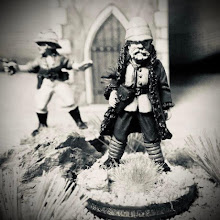In the scenario, after the completion of turn 8 a die is rolled at the beginning of each turn and then adding the number of turns that have been played. If the total equals 14 or more, the scenario ends. A hush fell over the darkened battlefield.
A seemingly inconclusive, bloody skirmish - just like many actual battles and fights of The French and Indian War. So which officer got the most Honor?
Lieutenant Charles Deschamps de Boishebert et de Raffetot:
1. +3 Honor for controlling the Objective Marker for the most turns.
2. +1 Honor causing at least 33% casualties to the enemy (in points).
Total: 4
Lieutenant Coll McDougall:
1. +1 Honor causing at least 33% casualties to the enemy (in points).
Total: 1
A French victory. Narratively both sides took heavy casualties and the British kinda, sorta held the field; but they are too disordered and exhausted to consolidate their gains - plus the French are still out their taking pot shots!
1. Love the feel of the large skirmish game.
2. Activations. As a retired soldier I know stuff happens! That flat terrain has an unexpected steep ditch you did not see; Pierre stumbles and twists his ankle; what did you want to do again? As expected, the more disciplined the unit (and the positioning of the officer) adds to a successful roll.
3. Firing. The firing mechanism I believe is right; 2 hits are required normally to remove a figure which replicates muskets quite nicely.
4. Light Infantry, Skirmishers, and Natives. These units are hard to hit in Firing as you would expect. The units count open terrain as cover requiring 3 hits to remove a figure; if in cover they need 4 hits, etc. As both sides were made up of these units, with only one exception, the firing usually only took out one or two figures at a time. It will be interesting as we acquire some line infantry to see how the Firing goes.
Take advantage of your special rules. That goes for me too!
4. Fighting. This was the big casualty producer until late in the game when the 42nd Highlanders were the only target. Bloody! Tomahawks, rifle butts and bayonets. True Hollywood fashion. As a side note, when the Rangers attacked the Huron Tribe, the Hurons forgot that they could counterattack - oh well.
5. Small Units (especially Skirmishers). At first glance they seem a bargain in points due to their lower cost and having the same amount of Firing/Fighting dice as a normal sized unit; but, they are so brittle. Once these smaller units started taking casualties, they were easily permanently disordered and/or routed. As a reminder, when disordered or permanently disordered they only fight with 1/2 of their dice. Skirmishers have a low discipline (except when upgraded) which is a challenge for activations and rallying. So you takes your chances and roll the dice!
6. Disorder the enemy! If you can keep as many of the enemy units disordered as possible, his fighting is weakened and he has to make decisions on whether to rally (meaning that's all he can do) or take the risk to stay disordered which is never a good idea and you are asking for a rout.
7. Shock Infantry in Close Order. Wow. When the 42nd hit the 1st Marine Company in an attack, it was a slaughter and caused the French to rout with their leader. Shock Infantry normally has a Fighting factor of 5+, plus the Highlanders were Aggressive making it a 4+, plus they were attacking making it a 3+, and finally, it was their first Firing/Fighting of the game giving them a +2. Line Infantry also has the first Firing/Fighting rule. Muskets are clean and not fouled with repeated firing using black powder and for Fighting, it represents men who are not tired, have their gander up and our ready to stick it to the enemy!
All in all the battle was exciting, fast, and a nail biter: The French almost pulled Defeat from the jaws of victory and British forgot that Close Order Infantry could pass through Light Infantry which might have tip the scales of the battle. Maybe.
"Next time my brave lads!"
So what will happen next? Both sides need to lick their wounds, reorganize and plan for their next encounter.
Until next time . . .
.JPG)
.JPG)
.JPG)
.JPG)




 Dismounted French Dragoons occupy Oberbratwurst. The yellow marker behind them signifies that the dragoons are disorganized. In other words, they lost their "battle formation" as they moved through the streets and will need some time to reorganize.
Dismounted French Dragoons occupy Oberbratwurst. The yellow marker behind them signifies that the dragoons are disorganized. In other words, they lost their "battle formation" as they moved through the streets and will need some time to reorganize.
 The Austrian Cuirassier units boldly charge into the French cavalry. The line behind the French consists of Bavarian Cuirassiers and more French Cavalry.
The Austrian Cuirassier units boldly charge into the French cavalry. The line behind the French consists of Bavarian Cuirassiers and more French Cavalry.

 The French Cavalry Commander, the Count d'Arco, boldly stares down the Austrians as he wonders where his cavalry command went.
The French Cavalry Commander, the Count d'Arco, boldly stares down the Austrians as he wonders where his cavalry command went.

.JPG)
.JPG)
.JPG)
.JPG)








































